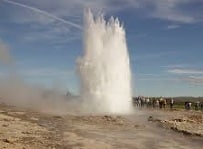In order to know the meaning of the term geyser, it is necessary, first of all, to discover its etymological origin. In this case, we can establish that it is a word that derives from Icelandic, specifically from "geysir." This is a noun that, in turn, comes from German, exactly from "geysa", which can be translated as "jet" or " torrent ".
This is the name given to a hot spring from which, periodically, steam and hot water emanate.
 It is estimated that there are approximately one thousand geysers around the world. For these structures to emerge, certain specific hydrogeological conditions must occur. Geyser activity occurs from the contact of water with rocks that are heated by underground magma .
It is estimated that there are approximately one thousand geysers around the world. For these structures to emerge, certain specific hydrogeological conditions must occur. Geyser activity occurs from the contact of water with rocks that are heated by underground magma .
The geyser is an opening on the surface that is connected via natural conduits to underground water reserves . As the geyser fills, the surface water cools little by little, but the water in the reservoir does not. In this way, the hot water exerts pressure on the surface water, heating it as well. When the boiling point of water is reached at the bottom of the geyser, the steam rises, causing the water to overflow. The pressure, meanwhile, causes a violent eruption to occur.
Once the geyser erupts , the water that remains in the geyser cools. The expelled hot water, meanwhile, seeps through the pores and fractures of the rock and the cycle begins again.
In addition to everything indicated, we cannot forget the existence of basically two types of geysers:
-Cone geysers, which receive this name because, precisely, what they come to "erupt" are cones of silicon agglomerates.
-Fountain geysers, which are called that because, in their case, what they do is "erupt" pools of water that appear quite violently.
The first known geyser is called Geysir and is located in Iceland . The term geyser, in fact, is linked to this hot spring, in turn named with an Icelandic word that refers to an eruption. Geysir can expel water about 80 meters high .
The place with the highest concentration of geysers is Yellowstone National Park , in the United States . Old Faithful geyser is the most famous in the region , erupting about five minutes per hour.
However, there are many other corners of the world that are also known for the number and variety of geysers they have. Among these aforementioned enclaves we can highlight the Kronotski Nature Reserve, which is located in Russia; El Tatio, located in Chile; the Taupo volcanic area, which is in New Zealand; the Haukadalur, which is located in Iceland or the Copahue volcano, which is in Chile.
In the same way, we cannot ignore that the word in question in capital letters, GEISER, gives shape to the acronym for Integrated Management of Registry Services, which works as a "Cloud" and is used by public organizations in Spain, within what is the Ministry of Territorial Policy and Public Function.
